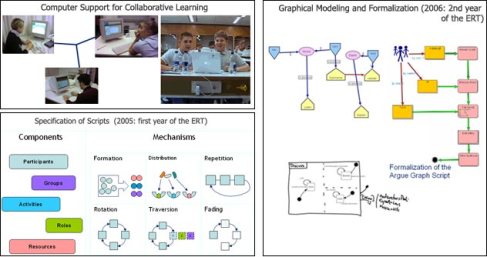 As already mentioned in previous essay, collaboration does not happen automatically and neither does computer supported collaborative learning. If the learning does not suffer modification, the adding of computers, projectors or mobile devices will make no or little effect on learning development.
As already mentioned in previous essay, collaboration does not happen automatically and neither does computer supported collaborative learning. If the learning does not suffer modification, the adding of computers, projectors or mobile devices will make no or little effect on learning development.
It is necessary to design the learning and learning goals carefully when using computer supported collaborative learning so that the technology can really effect on the improvement and development of the students’ knowledge construction.
There are benefits in designing collaborative teaching with the support of technology:
. It allows connections between students that would not meet other way
. It allows synchronous and asynchronous communication
. It generates a database for future reference
But, as in everything else in life, there are some difficulties too. Professor Weinberger in his lectures, lists some of them:
. little participation (of some members, that is, in other words uneven participation)
. little argumentative competence (which can and must be developed)
. cultural differences regarding learning styles and preferences
. motivationally devastating group effects, like the one caused by free riding
. Satisficing (aiming the minimum requirements of the task)
. Superficial consensus building (just to have the task done)
. Knowledge divergence (short of resources like time and means)
It is important to observe that these factors are also present in collaborative learning without the support of technology but some of them can be enlarged or masked by the use of technology that.
Professor Weinberger also mentioned that, according to Slavin´s theoretical model, the conditions that should be met so that collaboration effectively works are:
. individual responsibility (each member taking responsibility on the result)
. group reward (same to all members)
When these two conditions are met, collaboration’s outcome in learning is better than individual learning outcome. Of course it is necessary to keep in mind that not all tasks are suitable for collaborative interaction.
Weinberger mentioned that there is a reciprocal correlation between discourse process, cognitive process and individual acquisition of knowledge within the process of collaborative learning. This correlation is not linear but it is present anyway. Looking deeper in this process, we have to consider the elements of each part of the process:
Discourse process includes: participation, epistemic and argumentative quality, transactivity (relating the discussion) and knowledge convergence or divergence
Cognitive process includes: cognitive engagement and elaboration, sharing knowledge
Individual acquisition relates to outcomes: individual knowledge acquisition and knowledge convergence.
Collaboration can be supported by technology because it can be scripted in order to give tools so that discourse and cognitive processes take place and they do so by specifying, sequencing and determining roles and learning activities in the collaborative learning environments. Weinberger represented the scrip formation as follows:
The orchestration of the learning script can be done with a variety of possibilities. Besides orchestrating the task script, group distribution, defining the outcome, it is also possible to macro script the teaching by adding phases, like solo learning, team collaboration, class meetings, online meetings or publishing of outcomes.
Different script schemes will produce different processes and therefore, should be selected according to the expected outcome and interactions. He made a study with different scripts, aiming on different aspects:
. regulate learning activities, aiming to scaffold and balance the external and internal scripts. The weaker the internal scripts, the more the need of externals.
. provide complementary procedural knowledge, learners can direct themselves to the script in order to regulate their collaborative learning activities and build a new understanding. It may foster motivation and internalization of strategies.
. provide process-oriented instruction, in order to increase the frequency of specific behaviors by suggestions or prompts. It has the capability of instructing but also coercing learners.
. alleviate coordination, generating less effort in coordinating the activities, for transactive responses it is needed that the contributions are timely accessed.
. foster awareness, increasing the consciousness of the presence and activities of others in the group and it can work as a learning contract among group participants.
His study showed however that scripts should be adapted in order to meet the needs of the development of the students. Scripts should take into consideration the need for scaffolding, interaction and feedback or feedforward, therefore combinations should be made.
References:
- Weinberger, A. (2011). Principles of transactive computer-supported collaboration scripts. Nordic Journal of Digital Literacy, 6(3), 189-202.
- Video lecture by Prof. Armin Weinberger, ”CSCL and me. Some background
- Video lecture by Prof. Armin Weinberger, “Cooperative and Collaborative Learning “
- Video lecture by Prof. Armin Weinberger, “CSCL Processes”
- Video lecture by Prof. Armin Weinberger, “ A CSCL Script Example Study. Epistemic and Peer-Review Scripts”



